Turk Shahis
The Turk Shahis or Kabul Shahis were a dynasty of Western Turk, or mixed Western Turk-Hephthalite, origin, that ruled from Kabul and Kapisa to Gandhara in the 7th to 9th centuries CE.[1][7][8] They may have been of Khalaj ethnicity.[9][10][11] The Gandhara territory may have been bordering the Kashmir kingdom and the Kanauj kingdom to the east.[12] From the 560s, the Western Turks had gradually expanded southeasterward from Transoxonia, and occupied Bactria and the Hindu-Kush region, forming largely independent polities.[13] The Turk Shahis may have been a political extension of the neighbouring Western Turk Yabghus of Tokharistan.[7] In the Hindu-Kush region, they replaced the Nezak Huns – the last dynasty of Bactrian rulers with origins among the Xwn (Xionite) and/or Huna peoples (who are sometimes also referred to as "Huns" who invaded Eastern Europe during a similar period).[7]
Turk Shahis | |||||||||||||||||
|---|---|---|---|---|---|---|---|---|---|---|---|---|---|---|---|---|---|
| 665–870 CE[1][2] | |||||||||||||||||
 An early Turk Shahi ruler named "Lord Ranasrikari" (Brahmi script:
| |||||||||||||||||
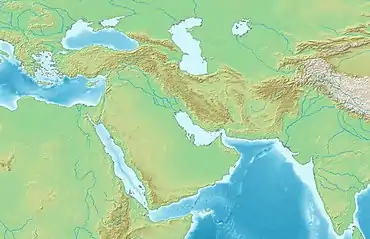 TURK SHAHIS Approximate location of the Turk Shahis | |||||||||||||||||
| Capital | Kabul | ||||||||||||||||
| Common languages | Bactrian | ||||||||||||||||
| Religion | Buddhism | ||||||||||||||||
| Tegin | |||||||||||||||||
• 665 - 680 | Barha Tegin | ||||||||||||||||
• 680 - c.739 | Khorasan Tegin Shah | ||||||||||||||||
• 739 - c.800 | Fromo Kesaro | ||||||||||||||||
• c.800 - 815 | Pati Dumi | ||||||||||||||||
• ? - c. 850 | Lagaturman | ||||||||||||||||
| Historical era | Early Middle Ages | ||||||||||||||||
• Established | 665 | ||||||||||||||||
• Disestablished | 870 CE[1][2] | ||||||||||||||||
| |||||||||||||||||
| Today part of | Afghanistan | ||||||||||||||||
Kabulistan was the heartland of the Turk Shahi domain, which at times included Zabulistan and Gandhara.[14]
The Turk Shahis arose at a time when the Sasanian Empire had already been destroyed by the Muslim forces of the Rashidun Caliphate.[1] The Turk Shahis then resisted for more than 200 years to the eastward expansion of the Muslim forces of the Abbasid Caliphate, effectively blocking the Muslim conquests in India, until they fell to the Persian Saffarids in the 9th century CE, and the Turkic Ghaznavids finally broke through into India after overpowering the declining Hindu Shahis and Gurjaras.[1][15][2] The long resistance of the Turk Shahis against Muslim expansion may have contributed to the preservation of Indian culture and Hinduism, as "the militant process of conversion" to Islam in conquered lands, which had deeply affected the Near East and the Iranian world, already "was a thing of the past" in the 10th century CE.[15]
Displacement of the Hunnish Nezak-Alchons
From around 625 CE, the Turks progressively displaced the Hunnish tribe of the Nezak, which also had incorporated the remnants of the Alchon Huns, first in Zabulistan (area of Ghazni) and then in Kabulistan (area of Kabul) and in Gandhara as far as the Indus river.[16][17] The Chinese pilgrim Xuanzang, visiting Kapisi in 629 CE, testified that "... the Turks have lived in the mountain area between Zabulistan and Kapisi".[18] Visiting the area a century later in 723–729, the Korean Buddhist pilgrim Hui Chao attested that the areas of Gandhara, Kapisa and Zabulistan were under Turk rule.[17]
Before the formal establishment of the Turks, the last local king of Kapisi was known in Chinese and Arab sources by the name of Ghar-ilchi (653-661 CE), and he had been formally installed as king of Jibin (former Kapisi/ Kabulistan) by the Chinese Tang Dynasty emperor in 653 CE, and again as Governor of Jibin under the newly formed Chinese Anxi Protectorate, the "Protectorate of the Western Regions", in 661 CE.[5][19] Ghar-ilchi may have been the last member of a local "Khingal dynasty" founded by Khingila.[19] The first known Turk ruler of Kapisi, named Barha Tegin, may have been initially a vassal in the service of Ghar-ilchi, who then revolted and usurped the throne.[19]
Vassalage to the Yabghus of Tokharistan
According to Chinese sources, in particular the chronicles of the Cefu Yuangui, the Turks in Kabul were vasals of the Yabghus of Tokharistan. When a young brother of the Tokhara Yabghu Pantu Nili, named Puluo (僕羅 púluó in Chinese sources), visited the court of the Tang Dynasty in Xi'an in 718 CE, he gave an account of the military forces in the Tokharistan region.[20]
Puluo described the power of "the Kings of Tokharistan", explaining that "Two hundred and twelve kingdoms, governors and prefects" recognize the authority of the Yabghus, and that it has been so since the time of his grandfather, that is, probably since the time of the establishment of the Yabghus of Tokharistan.[22] This account also shows that the Yabghu of Tokharistan ruled a vast area circa 718 CE, formed of the territories north and south of the Hindu Kush, including the areas of Kabul and Zabul.[23] Finally, Puluo reaffirmed the loyalty of Yabghu Pantu Nili towards the Tang Dynasty.[22]
Part of the Chinese entry for this account by Puluo is:
On the Dingwei day of the eleventh month in the sixth year of the Kaiyuan era, Ashi Tegin Puluo (阿史特勒僕羅) writes to the emperor: Tokhara Yabghu (吐火羅葉䕶), his elder brother, is controlling as his subordinates two hundred and twelve persons, such as the local kings of various states, Dudu (Governors-General), and Cishi (heads of regional governments). The king of Zabul rules two hundred thousand soldiers and horses, the king of Kabul two hundred thousand, each king of Khuttal, Chaghanian, Jiesu (解蘓國), Shughnan, Evdal (悒達國), Kumedha Wa'khan (䕶宻國), Guzganan, Bamiyan, Lieyuedejian (久越徳建國), and Badakhshan fifty thousand."
Rulers of Kabul (661 CE)
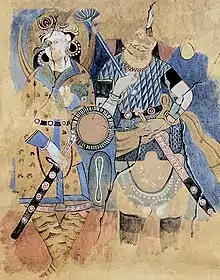
Between 661 and 665, Chinese and Arab sources indicate that a new Turkic ruler became Shah of Kabul, founding a "Turk Shahis" dynasty.[29] The Turkic rulers first had their capital in Kapisa (Begram), and then in Kabul as they expanded eastward.[5] Having lost Ghazni and Kabul, the Nezak dynasty declined rapidly as indicated by the progressive elimination of Nezak symbols from the historical coin record.
From the middle of the 7th century CE, the Turk Shahis emulated the coinage of their predecessors, the Hunnish Nezak-Alchons.[1][30] These coins use the same type of portrait as the Nezak, except that the Nezak crown adorned with a bull's head is replaced by a crown consisting in three crescent moons in the middle of which a flower or trident is set.[30] In other coins the triple-crescent moons were kept, and the king was shown wearing a Central Asian caftan.[5] A Bactrian script legend "σριο Þαυιο" or a Brahmi script legend "śrī ṣāhi" appears on some of these new coins, combining the honorific title "Sri" ("His Excellency/Illustriousness") and the title "King".[30] This new coinage corresponds to the formal establishment of the Turk Shahis, who, according to the literary sources arose sometime after 661 CE.[1][30]
Several of these coins are attributed to Shahi Tegin, the second Turk Shahi ruler, and dated to circa 700 CE.[31] After this transitory period, Turk Shahi coinage adopted the Sasanian coinage style, and added a trilingual legend in Greco-Bactrian, Pahlavi, and Brahmi. Based on finds, Turk Shahi coins apparently circulated in Zabulistan, Kabulistan, Gandhara and Uddiyana.[1]
The new region occupied by the Turk Shahis had numerous Buddhist monasteries, such as Mes Aynak, which appear to have remained in use until the 9th century CE.[5] Dedications including Turk Shahis coins have been found under a statue in the Buddhist monastery of Fondukistan.[1][32]
Al-biruni on the Turk Shahis
Al-Biruni in his Tārīkh al-Hind ("History of India") describes the rule of the Turk Shahis at Kabul.[33] He names their first king as "Barhatakin", who "wore Turkish dress, a short tunic open in front, a high hat, boots and arms".[33] This king "brought those countries under his sway and ruled them under the title of a Shahiya of Kabul. The rule remained among his descendants for generations, the number of which is said to be about sixty".[33] Al-biruni then describes the rise of the Hindu Shahis after them.[33]
._After_679_in_the_style_of_the_Nezak_Huns.jpg.webp) Early coin of Tegin Shah, in the style of the Nezak Huns, whom he displaced. Bactrian legend σριο Þανιο "Srio Shaho" with tamgha, late 7th century CE.
Early coin of Tegin Shah, in the style of the Nezak Huns, whom he displaced. Bactrian legend σριο Þανιο "Srio Shaho" with tamgha, late 7th century CE.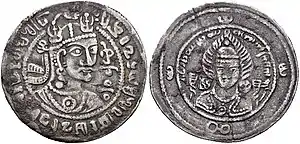 Trilingual coin of Tegin Shah towards the end of his reign. Iranian god Adur on the reverse. Date in Pahlavi: 728 CE
Trilingual coin of Tegin Shah towards the end of his reign. Iranian god Adur on the reverse. Date in Pahlavi: 728 CE
 The Bala Hissar fortress, west Kabul, originally built around the 5th century CE
The Bala Hissar fortress, west Kabul, originally built around the 5th century CE
Rule in Gandhara
The Turks under the Western Turk ruler Tong Yabghu Qaghan crossed the Hindu-Kush and occupied Gandhara as far as the Indus river from circa 625 CE.[16][17] Overall, the territory of the Turk Shahi extended from Kapisi to Gandhara, with a Turkic branch becoming independent in Zabulistan at one point.[12][35][9] The Gandhara territory may have been bordering the Kashmir kingdom and the Kanauj kingdom to the east.[12] The Turk Shahi capital of Gandhara, which possibly fonctionned as a winter capital alternating with the summer capital of Kabul, was Udabhandapura.[36]
The Korean pilgrim Hui Chao, visiting the area in 723-729 CE, mentionned that these regions were ruled by Turk kings. Of Gandhara, Hui Chao writes:[12]
I arrived at the country of Gandhara (建馱羅). The king and military personnel are all Turks (突厥 Tūquè). The natives are Hu people; there are also Brahmins (婆羅門). The country was formerly under the influence of the king of Kapisa. (...) Though the king is of Turkish origin, he greatly believes and respects the Three Jewels. The king, the royal consort, the prince, and the chiefs build monasteries separately and worship the Three Jewels (...) The city [probably the capital Udabhandapura][36] is built on the northern bank of the great Indus river. Three days' travel from this city to the west, there is a great monastery (...) called Kaniska. There is a great stupa which constantly glows. The monastery and the stupa were built by the former king Kaniska, so the monastery was named after him. (...) Both Mahayana and Hinayana are practised here."
Rule in Zabulistan
From 680 CE, the Turk Shahi ruler Tegin Shah was the king of the Turk Shahis, and ruled the area from Kabulistan to Gandhara as well as Zabulistan.[31][21] His title as given in Chinese sources was "Tegin, King of the Khorasan" (烏散特勤灑 Wusan Teqin Sa "Tegin Shah of Khorasan").[21] The area of Zabulistan eventually came to be ruled by Rutbil (Turkic: Iltäbär), his elder brother, who founded the dynasty of the Zunbils.[21] Their relationship was at times antagonistic, but they fought together against Arab incursions, and the Turk Shahis of Kabul took back control of the Zabulistan territory temporarily in 710 CE.[21]
Bamiyan and Kakrak region
Center and right: The triple-crescent crown in the "Hunter King" mural from Kakrak (7th-8th century CE) has a close similarity to the triple-crown in some of the coinage of Afghanistan, such as this early coin found in Ghazni, Zabulistan.[38][21] The coin is of the same type as this one.
Many of the late mural paintings surrounding the Buddhas of Bamiyan, or the paintings of Kakrak and Dukhtar-e Nushirvan are attributed to the "Turkic period" in the 7-8th centuries CE.[39] Several of these paintings show a variety of male devotees in double-lapel caftans.[40] These works of art display a sophistication and cosmopolitanism comparable to other works of art of the Silk Road such as those of Kizil, and are attributable to the sponsorship of the Western Turks.[40]
In nearby Kakrak, a valley next to Bamiyan, a famous Buddhist mural named "The Hunter King" (7-8th centuries CE) shows a typically local royal figure seated on a throne, his bow and arrows on the side. He wears a triple-crescent crown which is said to have a close similarity to the triple-crescent crowns on the coinage found in northeastern Afghanistan in the area of Zabulistan, for example this coin from Ghazni.[38][21] Other authors have attributed the triple-crescent crown to Hephthalite influence.[41] The painting may be an allegory of a King abandonning violence, particularly the hunting of animals, and converting to Buddhism.[42]
Conflict with the Arabs
Barha Tegin was the first ruler of the Turkh Shahis. He is mentionned by the Arab historian al-Biruni as the first Turkic Kabul Shah.[30] During their rule, the Turk Shahi were consistently an obstacle to the eastward expansion of the Abbasid Caliphate. Circa 665 CE, the Arabs attacked Shahi territory from the west for the time, and captured Kabul.[1][5][7] But the Turk Shahi under Barha Tegin were able to mount a counter-offensive and repulse the Arabs, taking back the areas of Kabul and Zabulistan (around Ghazni), as well as the region of Arachosia as far as Kandahar.[7][31]
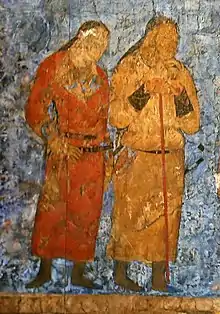
From 680 CE, his son Tegin Shah was the king of the Turk Shahis.[31] His title was "Khorasan Tegin Shah" (meaning "Tegin, King of the East"), and he was known in Chinese sources as 烏散特勤灑 Wusan Teqin Sa "Tegin Shah of Khorasan".[21] His grand title probably refers to his resistance to the peril of the Umayyad caliph from the west.[21] His territory comprised the area from Kabulistan to Gandhara and initially included Zabulistan, which came to be ruled by Rutbil (Turkic: Iltäbär), his elder brother, who founded the dynasty of the Zunbils.[21] Bactria, however, remained under the Yabghus of Tokharistan.[21]
The Arabs again failed to capture Kabul and Zabulistan in 697-698 CE, and their general Yazid ibn Ziyad was killed in the action.[7] Tegin Shah apparently regained complete suzerainty over Zabulistan in 710 CE.[21]
Embassy to China
The Turk Shahis, like the rest of the Western Turks, were nominally part of a protectorate under the Chinese Tang Dynasty since circa 658 CE.[47] According to Chinese sources, the Turks were preceded by a dynasty of twelves generations of rulers, starting with 馨孽 (Xinnie, possibly Khingila), the last king to be recognized by the Chinese being 曷擷支 (Hexiezhi) in 658 CE. It is thought that he was replaced by the Turks soon after.[48]
The territory of the Turk Shahis was nominally partitionned into several Chinese Commanderies under administration of the Anxi Protectorate: the city of Yege (modern Mihtarlam) east of Kabul was considered as the seat of a Chinese Commandery for the Jibin country, and named the Xiuxian Commandery (修鮮都督府, Xiūxiān Dūdùfû),[49] the city of Yan at the border with Gandhara was the seat of the Yuepan Commandery (悅般都督府, Yuèpān Dūdùfû), Ghazni was the seat of the Tiaozhi Commandery (條枝都督府, Tiáozhī Dūdùfû).[50]
In 719/20 CE, the Tegin of Kabulistan (Tegin Shah) and the Iltäbär of Zabulistan sent a combined embassy to the Chinese Emperor of the Tang Dynasty in Xi'an to obtain confirmation of their thrones.[21][49] The Chinese emperor signed an investiture decree, which was returned to the Turk rulers.[21] The Korean pilgrim Huei-ch’ao accompanied the return embassy in 726 CE, and wrote an account of his travel and visit at the court of Kabul, relating that Turk ("T’u-chüeh") kings ruled the territories of Gandhara, Kapisa and Zabulistan at the time, that they were Buddhists, and that the King of Kabul was the uncle of the ruler of Zabul.[51][21]
Contacts with the Byzantine Empire


Tegin Shah then abdicated in 739 CE in favour of his son, named on his coins "Fromo Kesaro", probable phonetic transcription of "Caesar of Rome".[7][52] He was apparently named in honor of "Caesar", the title of the then East Roman Emperor Leo III the Isaurian who had defeated their common enemy the Arabs during the Siege of Constantinople in 717 CE, and sent an embassy to China through Central Asia in 719 CE which probably met with the Turk Shahis.[7][lower-alpha 1] The Chinese annals record that "In the first month of the seventh year of the period Kaiyuan [719 CE] their Lord (拂菻王, "the King of Fulin") sent an officer of high rank of Tokhara [吐火羅大首領 T'u-huo-lo Ta-shou-ling)] (...) to offer lions and antelopes, two of each. A few months after, he further sent Priests of great virtue [大德僧 Ta-te-seng] to our court with tribute."[53] In Chinese sources "Fromo Kesaro" was aptly transcribed "Fulin Jisuo" (拂菻罽娑), "Fulin" (拂菻) being the standard Tang Dynasty name for "Byzantine Empire" and Jisuo (罽娑) the phonetic transcription of "Caesar".[19][54][52][55]
Fromo Kesaro appears to have fought vigorously against the Arabs, and his victories may have forged the Tibetan epic legend of King Phrom Ge-sar.[7] In 745 CE, Fromo Kesaro's son Bo Fuzhun (勃匐準 Bo Fuzhun in Chinese sources) became king and received the investiture from the Chinese court as king of Jibin (罽賓, Kapisa) and Wuchang (烏萇國, Khorasan), with the honorific title of "General of the Left Stalwart Guard" (左驍衞將軍).[56]
In 775–785, Arab sources mention a Turk Shahi ruler of Kabul named Khinkhil or Khinjil, who, according to Al-Yakubhi, was sent a messenger by Al-Mahdi in 775-785 asking for his submission, which he apparently gave.[57] There is possibility that the Khinkhil of the Arabs is identical with the Turk Shahi Bo Fuzhun (勃匐準) of the Chinese sources.[57]
Decline
The struggle between the Arabs and the Turk Shahis continued into the 9th century CE.[7] Hoping to take advantage of the Great Abbasid Civil War (811-819 CE), the Turk Shahi, named "Pati Dumi" in Arab sources, invaded parts of Khorasan.[19] Once the Abbasid caliph Al-Ma'mun prevailed in the Civil War, he sent troops to confront the Turk invaders: in 814/815 CE, the Turk Shahis were soundly defeated by these Arab troops, which pushed as far as Gandhara.[2] The Turk Shah now had to convert to Islam, and had to pay an annual tribute of 1,500,000 dirhams and 2,000 slaves to the Abbasid governor of Khorasan.[2] He also ceded a large and precious idol made of gold, silver and jewels, which was sent to Mecca, and placed in the Ka'ba.[19] Following Al-Azraqi's initial account of 834 CE, Quṭb ed-Dîn wrote:
Now, when this King converted to Islam, he decided that the throne with the idol should be given as an offering for the Ka'ba. He therefore sent the throne to Al-Ma'mun in Merv, who then sent it to Al-Hasan ibn Sahl in Wasit, who in turn charged one of his lieutenants from Balkh, Naçîr ben Ibrahim, with accompanying it to Mecca. This lieutenant arrived there in the year AH 201 (816 CE) during the time of pilgrimage when Isḥâḳ ben Mûsá ben ´Isá was leading the pilgrims to the holy sites. When they returned from Mina, Naçîr ben Ibrahim placed the throne with the carpet and the idol in the center of the square dedicated to Omar Ibn Al-Khattab, between Safa and Marwa, where it remained for three days.
— Quṭb ed-Dîn, History of the city of Mecca[58]
Al-Azraqi also made a very detailed description of the statue, which points to a crowned and bejewelled Buddha seated on a throne, a design otherwise well known and quite specific to this historical period for the region of Afghanistan and Kashmir.[59]
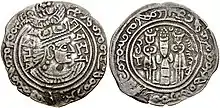
According to the Arab chronicler al-Biruni, the last Turk Shahi ruler of Kabul, Lagaturman, probable son of Pati Dumi,[19] was deposed by a Brahmin minister, named Kallar, or possibly Vakadeva, around 822 CE.[19][2][60][61][62] A new dynasty, the Hindu Shahi took over, with its capital in Kabul.[2]
Saffarids
In the south, the Zunbil Turks of Kandahar and Zabulistan fell in 870/871 CE to the Persian forces of the Saffarid dynasty under the powerful general Ya'qub ibn al-Layth al-Saffar (r. 861–879 CE), who led his offensive from Sistan.[63] He continued his offensive to Kabul, making the Kabul Shah prisoner, and plundering the "holy temple", where numerous statues of gold and silver were taken and dispatched to the caliph in Baghdad.[2] After their explusion by the Saffarids, the Hindu Shahs apparently retook Kabul in 879 CE, for a few years.[2]
Samanids and Ghaznavids
The Hindu Shahis were ultimately driven out by the Samanid ruler Ismail Samani around 900 CE.[2] The Hindu Shahis had to move their capital from Kabul to Udabhandapura in Gandhara, so as to have a better defensive position against Arab attacks.[2]
In 962 CE, the Turk ghulams Alp Tigin of the Samanid Empire, commander of the army in Khorasan, seized Ghazni and established himself there. He would be followed by his successors such as Abu Ishaq and Sebük Tigin, founder of the Ghaznavid dynasty.[64][65] At that time, the remnants of the local Buddhist Turk communities seem to have mingled with the newly arrived Muslim Turks of the Samanid Empire, forming an ethnic continuity among the ruling class of Ghazni, and local Buddhist Turks progressively converted to Islam.[65]
The Hindu Shahis resisted from their base in Gandhara until 1021 CE, when they were overrun by the Turkic Ghaznavids.[2]
Art under the Turk Shahis (7-8th century CE)
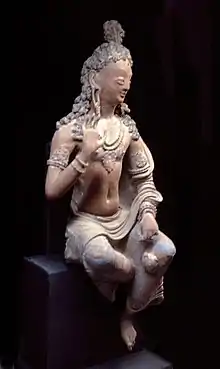
These was a relatively high level of artistic activity in the areas controlled by the Turk Shahis during 7-8th centuries CE, either as a result of the Sasanian cultural heritage, or as a result of the continued development of Buddhist art, with possible Hephthalite influence.[41] The art of Fondukistan in particular, dated to the 7th century, is considered as belonging "to the period of the Western Turks".[66] The Western Turks in Afghanistan are generally associated with a major revival of Gandharan Buddhist art between the 7th and 9th century CE, especially in the areas of Bamiyan, Kabul and Ghazni, with major new Buddhist sites such as Tapa Sardar in Ghazni, or Tepe Narenj and Mes Aynak near Kabul, which remained active at least until the 9th century CE.[65]
Geopolitical context
The Alchon Huns, predecessors of the Turk Shahis in Afghanistan and Gandhara, had brought destruction upon Buddhism, deeply weakening the Hellenitic art of Gandhara.[67] When Chinese pilgrim Xuanzang visited northwestern India in c. 630 CE, he reported that Buddhism had drastically declined, and that most of the monasteries were deserted and left in ruins.[68]
The renewed patronage of Buddhism in the area of Afghanistan during the 7-8th century CE is a function of the expansion of the Tang Dynasty power in Central Asia at that time, just as the Arabs were pressuring Khorasan and Sistan, right until the decisive Battle of Talas in 751.[69] The Kingdoms of Central Asia, often Buddhist or with an important Buddhist community, were generally under the formal control of the Tang Dynasty, had regular exchanges with China, and expected Tang protection.[69] Chinese monks were probably directly in charge of some of the Buddhist sancturies of Central Asia, such as the temple of Suiye (near Tokmak in present-day Kirghizistan).[69] During this period too, the Chinese Tang Empire extended its influence and promotion of Buddhism to the kingdoms of Central Asia, including Afghanistan, with a corresponding influx of Chinese monks, while there was conversely a migration of Indian monks and artistic styles from India to Central Asia, as "Brahmanical revivalism" was pushing Indian Buddhist monks out of their country.[70][69] Hellenistic Buddhist art, which had flourished for several centuries, was thus succeeded by a Sinicized-Indian phase during the 7th to 9th century CE.[70] This process and chronology are visible in the archaeological site of Tapa Sardar near Ghazni in Afghanistan, while this new form of art appears in its mature state in Fondukistan.[71]
At the end of the 10th century, the Samanid Empire led by the Turk ghulams Alp Tigin established itself in Eastern Afghanistan, later followed by the Ghaznavid dynasty.[64][65] At that time, local Buddhist Turk communities seem to have mingled with the newly arrived Muslim Turks of the Samanid Empire, forming an ethnic continuity among the ruling class of Ghazni. The local Buddhist Turks progressively islamized, but there was a continuation in artistic development and Buddhist religious activities, not a break.[65] The Buddhist site of Qol-i Tut in Kabul remained in use until the end of the 11th century.[65]
Turk support of Buddhism
The Turk Shahis are reported as having been supporters of Buddhism, and are generally presented as Buddhists.[72][73] The Korean pilgrim Hui Chao in 726 CE recorded in the Chinese language that the Turkic (突厥, Tū-chuèh) rulers of Kapisa ("Jibin") followed the Triratna and dedicated many Buddhist temples:[72]
(...) 至罽賓國。(...) 此國土人是胡。王及兵馬突厥。(...) 國人大敬信三寶。足寺足僧。百姓家各絲造寺。供養三寶。大城中有一寺。名沙糸寺。寺中貝佛螺髻骨舍利見在王官百姓每日供養。此國行小乘。
(...) I arrived in Jibin.(...) The natives of the country are Hu (Barbarian) people; the king and the cavalry are Turks (突厥, "Tuque"). (...) The people of this country greatly revere the Three Jewels. There are many monasteries and monks. The common people compete in constructing monasteries and supporting the Three Jewels. In the big city there is a monastery called Sha-hsi-ssu. At present, the curly hair (ushnisha, 螺髻) and the relic bones of the Buddha are to be seen in the monastery. The king, the officials, and the common people daily worship these relics. Hinayana (小乘) Buddhism is practised in this country.
The Chinese pilgrim Wulong arrived in Gandhara in 753 CE.[72] According to him, the country of Kapisi had its eastern capital in Gandhara during the winter, and its capital in Kapisi during the summer.[72] In Kashmir, which he visited from 756 to 760 CE, he explained that Buddhist temples were dedicated by the Tü-kiu ("Turk") kings.[72] Brahmanism too seems to have flourished, but to a lesser extent, under the Turk Shahis, with various works of art also attributed to their period.[72][77]
Buddhist works of art
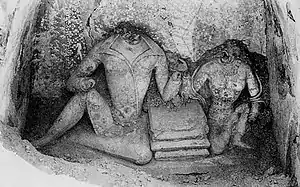
The works of art of this period in eastern Afghanistan, with a sophistication and iconography comparable to other works of art of the Silk Road such as those of Kizil, are attributable to the sponsorship of the "cosmopolitan" Turks, rather than their "Ephthalite" predecessors in this area (the Nezak-Alchon Huns), who, in the words of Edmund Bosworth, "were not capable of such work".[40] And, soon after, the expansion of Islam made the creation of such works of art impossible.[40]
The style as well as the techniques used in making these works of art (modelling of clay mixed with straw, wool or horsehair), are characteristic of the paintings and sculptures of Central Asia.[80] The production of Fondukistan must correspond to the southermost expansion of this particular type of Buddhist art.[80]
Devotees or sponsors wearing Central Asian clothes such as the tight-fitting double-lapel caftan appear in the Buddhist Monastery of Fondukistan, as in the statue of a King wearing the caftan and pointed boots, seated together with a Queen of Indian type, and dated to the 7th century CE.[81][30]
Datation
Dedications including coins of the Buddhist Turk Shahis and one Sasanian coin of Khusro II have been found under the statue of the royal couple with a king in Turk attire in the monastery of Fondukistan, providing important insights regarding the datation of the statue as well as Buddhist art in general: as a result of the analysis the statue can be dated to after 689 CE, and as a consequence a date of circa 700 CE is generally given for it and the other works of art of Fondukistan.[26][1][32] The royal couple consists in a princess in "Indian" dress, and a prince "wearing a rich caftan with double lapel and boots", characteristic of Central Asian clothing.[82][83]
 Mural of a Bodhisattva at the entrance of the niche of the royal couple. Fondukistan monastery, circa 700 CE
Mural of a Bodhisattva at the entrance of the niche of the royal couple. Fondukistan monastery, circa 700 CE Statue of the Buddha wearing the Iranian three-pointed camail, Ghorband valley, Fondukistan monastery, circa 700 CE.[84]
Statue of the Buddha wearing the Iranian three-pointed camail, Ghorband valley, Fondukistan monastery, circa 700 CE.[84] The period of the Turk Shahis also corresponds to the last stages of Greco-Buddhist art. circa 700 CE, Fondukistan monastery,Ghorband District, Afghanistan
The period of the Turk Shahis also corresponds to the last stages of Greco-Buddhist art. circa 700 CE, Fondukistan monastery,Ghorband District, Afghanistan Buddhist Devata statue from Udabhandapura, the Gandhara capital of the Turk Shahis, 6-7th century CE. Museum of Oriental Art (Turin).
Buddhist Devata statue from Udabhandapura, the Gandhara capital of the Turk Shahis, 6-7th century CE. Museum of Oriental Art (Turin).
Brahmanical works of art
.jpg.webp)
Brahmanism too seems to have flourished to some extent under the Turk Shahis, with various works of art also attributed to their period.[89][90] In particular the famous statue of a Sun deity that is either Mitra or Surya in tunic and boots discovered in Khair Khaneh near Kabul,[86] as well as a statue of Ganesha from Gardez are now attributed to the Turk Shahis in the 7-8th century CE, and not to their successors the Hindu Shahus as formerly suggested.[89] In particular, great iconographical and stylistic similarities with the works of the Buddhist monastery of Fondukistan have been identified.[89] Archaeologically, the construction of the Khair Khaneh temple itself is now dated to 608-630 CE, at the beginning of the Turk Shahis period.[91] The marble statue of Ganesha from Gardez is now attributed to the Turk Shahis,[89] and was donated by a certain Śrī Ṣāhi Khiṃgāla, ruler in the Kabul area, who could be the Turk Shahi ruler only known from Chinese sources as Bo Fuzhun (勃匐準 Bo Fuzhun in Chinese sources), the son of Fromo Kesaro, who acceded to the throne in 745 CE.[92][93]
.jpg.webp) Khair Khaneh sanctuary (reconstitution), dated to 608-630 CE.[91]
Khair Khaneh sanctuary (reconstitution), dated to 608-630 CE.[91].jpg.webp) Khair Khaneh donor, wearing a tunic and boots
Khair Khaneh donor, wearing a tunic and boots The Gardez Ganesha is now dated to the 8th century and attributed to the Turk Shahis.[89]
The Gardez Ganesha is now dated to the 8th century and attributed to the Turk Shahis.[89]
Rulers
- Barha Tegin (-680 CE).[94]
- Tegin Shah (680-739 CE)
- Fromo Kesaro (739-745 CE)
- Bo Fuzhun (745-?) Name known from Chinese sources.[49]
- Khinkhil (circa 780–785) Name known from Arab sources.[57]
- Pati Dumi (-815 CE) Name known from Arab sources
- Lagaturman (815-c.850 CE) Name known from Arab sources
References
- "Contained within a clay urn were a gold bracteate with the portrait of a ruler, three early drachms of the Turk-Shahis (Type 236, one of which is countermarked), and a countermarked drachm of the Sasanian king Khusro II dating from year 37 of his reign (= 626/7). The two countermarks on Khusro 's drachm prove that the urn could only have been deposited after 689" ALRAM, MICHAEL (2014). "From the Sasanians to the Huns New Numismatic Evidence from the Hindu Kush" (PDF). The Numismatic Chronicle (1966-). 174: 282–285. ISSN 0078-2696. JSTOR 44710198.
- Alram, Michael; Filigenzi, Anna; Kinberger, Michaela; Nell, Daniel; Pfisterer, Matthias; Vondrovec, Klaus. "The Countenance of the other (The Coins of the Huns and Western Turks in Central Asia and India) 2012-2013 exhibit: 16. THE HINDU SHAHIS IN KABULISTAN AND GANDHARA AND THE ARAB CONQUEST". Pro.geo.univie.ac.at. Kunsthistorisches Museum Vienna. Retrieved July 22, 2017.
- Millward, James A. (2007). Eurasian Crossroads: A History of Xinjiang. Columbia University Press. p. 31. ISBN 978-0-231-13924-3.
- Göbl 1967, 254 ; Vondrovec type 254
- Alram, Michael; Filigenzi, Anna; Kinberger, Michaela; Nell, Daniel; Pfisterer, Matthias; Vondrovec, Klaus. "The Countenance of the other (The Coins of the Huns and Western Turks in Central Asia and India) 2012-2013 exhibit: 13. THE TURK SHAHIS IN KABULISTAN". Pro.geo.univie.ac.at. Kunsthistorisches Museum Vienna. Retrieved July 16, 2017.
- See coin 3 from the same ruler in Alram, Michael; Filigenzi, Anna; Kinberger, Michaela; Nell, Daniel; Pfisterer, Matthias; Vondrovec, Klaus. "The Countenance of the other (The Coins of the Huns and Western Turks in Central Asia and India) 2012-2013 exhibit: 14. KABULISTAN AND BACTRIA AT THE TIME OF "KHORASAN TEGIN SHAH"". Pro.geo.univie.ac.at. Kunsthistorisches Museum Vienna. Retrieved July 16, 2017.
- Kim, Hyun Jin (19 November 2015). The Huns. Routledge. pp. 58–59. ISBN 978-1-317-34090-4.
- "The advance of Islamic forces both into Tokharistan in the north and into Zabulistan farther south was opposed by local rulers of probably Western Turkish identity" in Vondrovec, Klaus. "Coinage of the Nezak": 181. Cite journal requires
|journal=(help) - "The new rulers of Kabul, who according to me were Khalaj Turks, extended their rule over the
former territory of the Kapisi kingdom [Kapisa to Gandhara], while a branch of them became independent in Zabulistan. A Korean
monk Huichao (慧超) who visited these regions in the third decade of the 8th century, reported that both regions were ruled by the Turkish kings." Inaba, Minoru. "From Kesar the Kābulšāh and Cenral Asia": 443–444. Cite journal requires
|journal=(help) - Rezakhani, Khodadad (2017-03-15). ReOrienting the Sasanians: East Iran in Late Antiquity. Edinburgh University Press. p. 165. ISBN 978-1-4744-0030-5.
A Bactrian Document (BD T) from this period brings interesting information about the area to our attention. In it, dated to BE 476 (701 AD), a princess identified as `Bag-aziyas, the Great Turkish Princess, the Queen of Qutlugh Tapaghligh Bilga Sävüg, the Princess of the Khalach, the Lady of Kadagestan offers alms to the local god of the region of Rob, known as Kamird, for the health of (her) child. Inaba, arguing for the Khalaj identity of the kings of Kabul, takes this document as a proof that the Khalaj princess is from Kabul and has been offered to the (Hephthalite) king of Kadagestan, thus becoming the lady of that region. The identification of Kadagestan as a Hephthalite stronghold is based on Grenet's suggestion of the survival of Hephthalite minor stares in this region...
- "ḴALAJ i. TRIBE – Encyclopaedia Iranica". iranicaonline.org. Retrieved 2021-01-15.
- Inaba, Minoru (2010). Khotan in the last quarter of the first millennium: is there artistic evidence of the interrelation between Khotan and Tibet? A preliminary survey, Coins, Art and Chronology II: From Kesar the Kābulšāh and Cenral Asia. Vienna: Verlag der Österreichischen Akademie der Wissenschaften. pp. 443–444.
- "The period from 560 CE onwards would be that of the Western Turks, although it is not clear how and foremost when they gained power over Bactria and the Hindukush-region. Minoru Inaba states that "gradually having extended their power, they came to be independent ..."" in Vondrovec, Klaus. "Coinage of the Nezak": 173. Cite journal requires
|journal=(help) - "The Countenance of the other (The Coins of the Huns and Western Turks in Central Asia and India) 2012-2013 exhibit: 15. The Rutbils of Zabulistan and the "Emperor of Rome"". Pro.geo.univie.ac.at. Kunsthistorisches Museum Vienna. Retrieved July 22, 2017.
- Kim, Hyun Jin (19 November 2015). The Huns. Routledge. pp. 62–64. ISBN 978-1-317-34091-1.
- Klaus Vondrovec (2014). Coinage of the Iranian Huns and Their Successors from Bactria to Gandhara (4th to 8th Century CE). ISBN 978-3-7001-7695-4.
- Laet, Sigfried J. de; Herrmann, Joachim (January 1996). History of Humanity: From the seventh century B.C. to the seventh century A.D. UNESCO. p. 475. ISBN 978-92-3-102812-0.
- Vondrovec, Klaus. "Coinage of the Nezak": 173. Cite journal requires
|journal=(help) - Rahman, Abdur; Bopearachchi (Ed.), Osmund; Boussac (Ed.), Marie-Françoise (2002). Afghanistan. Ancien Carrefour entre l'Est et l'Ouest (New Light on Khingal, Turk and Hindu Shahis) (PDF). XV. Turnhout, Belgium: Brepols. pp. 37–41. ISBN 2-503-51681-5.CS1 maint: extra text: authors list (link)
- Kuwayama, S. (2002). Across the Hindukush of the First Millennium: a collection of the papers (PDF). Kyoto University. p. 139.
- Alram, Michael; Filigenzi, Anna; Kinberger, Michaela; Nell, Daniel; Pfisterer, Matthias; Vondrovec, Klaus. "The Countenance of the other (The Coins of the Huns and Western Turks in Central Asia and India) 2012-2013 exhibit: 14. KABULISTAN AND BACTRIA AT THE TIME OF "KHORASAN TEGIN SHAH"". Pro.geo.univie.ac.at. Kunsthistorisches Museum Vienna. Retrieved July 16, 2017.
- Sims-Williams, Nicholas (2002). "Nouveaux document bactriens du Guzgan (note d'information)". Comptes rendus des séances de l'Académie des Inscriptions et Belles-Lettres. 146 (3): 1057. doi:10.3406/crai.2002.22500.
- "The account herewith quoted as 3.5. shows that this king of Tokhara had political power to control the principalities belonging to the Governors-General to the north and the south of the Hindukush, not to mention the Yuezhi Governor General." in Kuwayama, Shoshin (2005). "Chinese Records on Bamiyan: Translation and Commentary". East and West. 55 (1/4): 153, 3–5. ISSN 0012-8376. JSTOR 29757642.
- Kuwayama, Shoshin (2005). "Chinese Records on Bamiyan: Translation and Commentary". East and West. 55 (1/4): 143–144. ISSN 0012-8376. JSTOR 29757642.
- Original text of Cefu Yuangui 3.5. Fanyan in Vol. 999: 六年十一月丁未阿史特勒僕羅上書訴曰僕羅克吐火羅葉䕶部下管諸國王都督刺史總二百一十二人謝颺國王統領兵馬二十萬衆罽賔國王統領兵馬二十萬衆骨吐國王石汗那國王解蘓國王石匿國王悒達國王䕶宻國王䕶時健國王范延國王久越徳建國王勃特山王各領五萬衆僕羅祖父已来並是上件諸國之王蕃望尊重僕羅兄般都泥利承嫡繼襲先𫎇恩勑差使持節就本國册立為王然火羅葉䕶積代以來扵大唐忠赤朝貢不絶本國緣接近大食吐蕃東界又是西鎮僕羅兄每徴發部落下兵馬討論擊諸賊與漢軍相知聲援應接在扵邊境所以免有侵漁僕羅兄前後屢𫎇聖澤媿荷國恩遂發遣僕羅入朝侍衛玉階至願獻忠殉命以為臣妾僕羅至此為不解漢法鴻臚寺不委蕃望大小有不比類流例髙下相懸即奏擬授官竊見石國龜兹并余小國王子首領等入朝元無功効並緣蕃望授三品将軍况僕羅身恃勤本蕃位望與親王一種北䫫大小與諸國王子懸殊却授僕羅四品中郎但在蕃王子弟娑羅門瞿曇金剛龜兹王子白孝順等皆數改轉位至諸衛將軍唯僕羅最是大蕃去神龍元年𫎇恩勑授左領軍衛翊府中郎將至今經一十四年久被淪屈不𫎇准例授職不勝苦屈之甚勑鴻臚卿准例定品秩勿令稱屈 in "冊府元龜 (四庫全書本)/卷0999 - 维基文库,自由的图书馆". zh.m.wikisource.org.
- Novotny, Susanne (1 January 2007). "The Buddhist Monastery of Fondukistān, Afghanistan – A Reconstruction". Journal of Inner Asian Art and Archaeology. 2: 31–37. doi:10.1484/J.JIAAA.2.302542. ISSN 1783-9025.
- Hackin, J. (1938). "Les travaux de la Délégation archéologique française en Afghanistan: COMPTE-RENDU SOMMAIRE (SEPTEMBRE 1936-AOÛT 1937)". Revue des arts asiatiques. 12 (1): 10–11. ISSN 0995-7510. JSTOR 43475079.
- Bosworth also says that the "Ephthalites were incapable of such work" in Bosworth, C. Edmund (15 May 2017). The Turks in the Early Islamic World. Routledge. p. 145. ISBN 978-1-351-88087-9.
- "The Countenance of the other (The Coins of the Huns and Western Turks in Central Asia and India) 2012-2013 exhibit: 13. The Turk Shahis in Kabulistan". Pro.geo.univie.ac.at. Kunsthistorisches Museum Vienna. Retrieved July 16, 2017.
- Alram, Michael; Filigenzi, Anna; Kinberger, Michaela; Nell, Daniel; Pfisterer, Matthias; Vondrovec, Klaus. "The Countenance of the other (The Coins of the Huns and Western Turks in Central Asia and India) 2012-2013 exhibit: 12. ZABULISTAN: FROM THE ALKHAN-NEZAK CROSSOVER TO THE TURKS". Pro.geo.univie.ac.at. Kunsthistorisches Museum Vienna. Retrieved July 16, 2017.
- Vondrovec, Klaus. Coins, Art and Chronology II - The First Millennium C.E. in the Indo-Iranian Borderlands (Coinage of the Nezak). p. 183.
- For the photograph of the famous statue, named the "Royal Couple of Fondukistan", see: "FONDOQESTĀN – Encyclopaedia Iranica". iranicaonline.org.
- Kuwayama, Shoshin (1976). "The Turki Śāhis and Relevant Brahmanical Sculptures in Afghanistan". East and West. 26 (3/4): 403. ISSN 0012-8376. JSTOR 29756318.
- Jan, Yun-Hua; Iida, Shotaro; Yang, Han-Sung (1984). The Hye Ch'O Diary: Memoir of the Pilgrimage to the Five Regions of India (Religions of Asia Series) (English and Korean ed.). Asian Humanities Pr. pp. 50–51. ISBN 978-0895810243.
- Dani, Ahmad Hasan; Litvinsky, B. A. (January 1996). History of Civilizations of Central Asia: The crossroads of civilizations, A.D. 250 to 750. UNESCO. p. 375. ISBN 978-92-3-103211-0.
- "The capital of the state of Kapisa–Gandhara (possibly, its winter capital) was Udabhandapura, now the settlement of Hund, situated on the right bank of the Kabul river. Most of the city was surrounded by a defensive rampart." in Harmatta, J.; Litvinsky, B. A. (1992). History of Civilizations of Central Asia: Tokharistan and Gandhara under Western Türk Rule (650-750). Unesco. p. 391. ISBN 978-92-3-103211-0.
- "又從迦葉彌羅國西北隔山一月程至建馱羅。此王及兵馬。總是突厥。土人是胡。兼有婆羅門。此國舊是罽賓王王化。為此突厥王阿耶領一部落兵馬。投彼罽賓王。於後突厥兵盛。便殺彼罽賓王。自為國主。因茲國境突厥覇王此國已北。並住中。其山並燋無草及樹。衣著人風言音節氣並別。衣是皮𣬼㲲衫靴袴之類土地宜大麥小麥。全無黍粟及稻。人多食麨及餅。唯除迦葉彌羅大勃小勃揚同等國。即此建馱羅國。乃至五天崑崙等國。總無蒲□□□甘蔗。此突厥王象有五頭。羊馬無數。駝騾驢等甚□多。地與胡□□□□□迴不過。向南為道路險惡。多足劫賊。從茲已北。西業者多市店之間。極多屠殺。此王雖是突厥。甚敬信三寶。王王妃王子首領等。各各造寺。供養三寶。此王每年兩迴設無遮大齋。但是緣身所受用之物。妻及象馬等。並皆捨施。唯妻及象。令僧斷價。王還自贖。自餘駝馬金銀衣物家具。聽僧貨賣。自分利養此王不同餘已北突厥也。兒女亦然。各各造寺。設齋捨施。此城俯臨辛頭大河北岸而置。此城西三日程有一大寺。即是天親菩薩無着菩薩所住之寺。此寺名葛諾歌。有一大塔。每常放光。此寺及塔。舊時葛諾歌王造。從王立寺名也。又此城東南□里。即是佛過去為尸毘王救鴿處。見有寺有僧。又佛過去捨頭捨眼餧五夜叉等處。並在此國中。在此城東南山裏。各有寺有僧。見今供養。此國大小乘俱行" in "遊方記抄 第1卷 Paragraph 0977b06". tripitaka.cbeta.org.
- Joseph Hackin affirms the "close connection" between the triple-crescent crown of the Kakrak Hunter King and this coin from Ghazni, Zabulistan, also describing the double-lapel caftan worn by the ruler on the coin: Hackin, Joseph (1936). L'Œuvre de la Délégation Archéologique Française en Afghanistan (1922-1932) : vol.1. p. 49.
- Sauer, Eberhard (5 June 2017). Sasanian Persia: Between Rome and the Steppes of Eurasia. Edinburgh University Press. p. 240. ISBN 978-1-4744-2068-6.
- Bosworth also says that the "Ephthalites were incapable of such work" in Bosworth, C. Edmund (15 May 2017). The Turks in the Early Islamic World. Routledge. p. 145. ISBN 978-1-351-88087-9.
- Compareti, Matteo (2008). "The Painting of the "Hunter-King" at Kakrak: Royal Figure or Divine Being?". Studio Editoriale Gordini: 133.
- "According to Jäger’s interpretation, the so-called «Hunter-King» was a symbolic representation of a royal person who converted to Buddhism and abandoned hunting and violence in general." in Compareti, Matteo (2008). "The Painting of the "Hunter-King" at Kakrak: Royal Figure or Divine Being?". Studio Editoriale Gordini: 133.
- Baumer, Christoph (18 April 2018). History of Central Asia, The: 4-volume set. Bloomsbury Publishing. p. 243. ISBN 978-1-83860-868-2.
- Grenet, Frantz (2004). "Maracanda/Samarkand, une métropole pré-mongole". Annales. Histoire, Sciences Sociales. 5/6: Fig. B.
- Whitfield, Susan (2004). The Silk Road: Trade, Travel, War and Faith. British Library. Serindia Publications, Inc. p. 110. ISBN 978-1-932476-13-2.
- Yatsenko, Sergey A. (2009). "Early Turks: Male Costume in the Chinese Art Second half of the 6th – first half of the 8th cc. (Images of 'Others')". Transoxiana. 14: Fig.25.
- "China, at the other end of Central Asia, managed to bring the Western branch of the Qaγanate under Tang supremacy in 658 CE and consequently established a protectorate in Bactria which also extended south of the Hindukush." in Vondrovec, Klaus. "Coinage of the Nezak": 681. Cite journal requires
|journal=(help) - Balogh, Dániel (12 March 2020). Hunnic Peoples in Central and South Asia: Sources for their Origin and History. Barkhuis. pp. 104–107. ISBN 978-94-93194-01-4.
- Balogh, Dániel (12 March 2020). Hunnic Peoples in Central and South Asia: Sources for their Origin and History. Barkhuis. p. 104. ISBN 978-94-93194-01-4.
- Theobald, Ulrich. "The Western Territories 西域 (www.chinaknowledge.de)". www.chinaknowledge.de.
- "The definitive annexation of Tokharistan and Gandhara to the Western Türk Empire was to take place some years later, in c. 625, when Sasanian Iran became involved in the war against Byzantium that ultimately led to its eclipse." in Dani, Ahmad Hasan; Litvinsky, B. A. (January 1996). History of Civilizations of Central Asia: The crossroads of civilizations, A.D. 250 to 750. UNESCO. pp. 370–375. ISBN 978-92-3-103211-0.
- Piras, Andrea. "FROMO KESARO. Echi del prestigio di Bisanzio in Asia Centrale, in Polidoro. Studi offerti ad Antonio Carile, a cura di G. Vespignani (Centro italiano di Studi sull'Alto Medioevo), Spoleto 2013, pp. 671-690": 681. Cite journal requires
|journal=(help) - Old Book of Tang (舊唐書 Jiu Tangshu), ch. 198 (written mid-10th Century C.E.), for 618-906 C.E: "開元七年正月,其主遣吐火羅大首領獻獅子、羚羊各二。不數月,又遣大德僧來朝貢" quoted in English translation in Hirth, F. (1885). China and the Roman Orient: Researches into their Ancient and Mediaeval Relations as Represented in Old Chinese Records. Shanghai & Hong Kong.
- Balogh, Dániel (12 March 2020). Hunnic Peoples in Central and South Asia: Sources for their Origin and History. Barkhuis. p. 106. ISBN 978-94-93194-01-4.
- Li, Qiang (2017). "HANDBOOK OF THE INTERNATIONAL SYMPOSIUM ON " BYZANTINE GOLD COINS IN THE WORLD OF LATE ANTIQUITY "". 中国 · 长春.
- 天寶四年,又冊其子勃匐準為襲罽賓及烏萇國王,仍授左驍衞將軍。"Kesar's son Bo Fuzhun succeed him on the throne as the king of Jibin and Wuchang. He was conferred the title General of the Left Stalwart Guard" in Balogh, Dániel (12 March 2020). Hunnic Peoples in Central and South Asia: Sources for their Origin and History. Barkhuis. p. 104. ISBN 978-94-93194-01-4.
- KUWAYAMA, Shoshin (1999). "HistoricalNotesonKapislandKabul intheSixth-EighthCenturies" (PDF). ZINBUN. 34: 44.
- transl. from Wüstenfeld (Wüstenfeld, III, 186: 190–191). The transcription of the Arabic follows Wüstenfeld. in Klimburg-Salter, Deborah (210). "Cultural Mobility, a Case Study: the Crowned Buddha of the Kabul Shāh" in: COINS, ART AND CHRONOLOGY II THE FIRST MILLENNIUM C.E. IN THE INDO-IRANIAN BORDERLANDS. ÖSTERREICHISCHE AKADEMIE DER WISSENSCHAFTEN. pp. 42–43.
- "As we shall see, this particular conjunction of iconographic features described by al-Azraqî is quite rare and is in fact limited to the northwest of the subcontinent – from Afghanistan to Kashmir – and to this period." in Klimburg-Salter, Deborah (210). "Cultural Mobility, a Case Study: the Crowned Buddha of the Kabul Shāh" in: COINS, ART AND CHRONOLOGY II THE FIRST MILLENNIUM C.E. IN THE INDO-IRANIAN BORDERLANDS. ÖSTERREICHISCHE AKADEMIE DER WISSENSCHAFTEN. p. 46.
- D. W. Macdowall, "The Shahis of Kabul and Gandhara" Numismatic Chronicle, Seventh Series, Vol. III, 1968, pp. 189-224, see extracts in R. T. Mohan, AFGHANISTAN REVISITED ... Appendix –B, pp. 164-68
- Raizada Harichand Vaid, Gulshane Mohyali, II, pp. 83 and 183-84.
- H. G. Raverty, Tr. Tabaqat-i-Nasiri of Maulana Minhaj-ud-din, Vol. I, p. 82
- Alram, Michael; Filigenzi, Anna; Kinberger, Michaela; Nell, Daniel; Pfisterer, Matthias; Vondrovec, Klaus. "The Countenance of the other (The Coins of the Huns and Western Turks in Central Asia and India) 2012-2013 exhibit: 15. THE RUTBILS OF ZABULISTAN AND THE "EMPEROR OF ROME"". Pro.geo.univie.ac.at. Kunsthistorisches Museum Vienna. Retrieved July 16, 2017.
- Sinor, Denis, ed. (1990), The Cambridge History of Early Inner Asia, Cambridge University Press, ISBN 9780521243049
- Rienjang, Wannaporn; Stewart, Peter (2 September 2020). The Global Connections of Gandhāran Art: Proceedings of the Third International Workshop of the Gandhāra Connections Project, University of Oxford, 18th-19th March, 2019. Classical Art Research Centre. p. 13. ISBN 978-1-78969-696-7.
- Statue of the seated Devata: "époque des Turcs Occidentaux, 7e siècle" in "Guimet Museum".
- Kim, Hyun Jin; Vervaet, Frederik Juliaan; Adali, Selim Ferruh (5 October 2017). Eurasian Empires in Antiquity and the Early Middle Ages: Contact and Exchange between the Graeco-Roman World, Inner Asia and China. Cambridge University Press. pp. 260–270. ISBN 978-1-108-12131-6.
- Ann Heirman; Stephan Peter Bumbacher (11 May 2007). The Spread of Buddhism. Leiden: BRILL. p. 60. ISBN 978-90-474-2006-4.
- Verardi, Giovanni; Paparatti, Elio (2005). "From Early to Late Tapa Sardār: A Tentative Chronology". East and West. 55 (1/4): 432–433. ISSN 0012-8376. JSTOR 29757657.
- Verardi, Giovanni; Paparatti, Elio (2005). "From Early to Late Tapa Sardār: A Tentative Chronology". East and West. 55 (1/4): 437–438. ISSN 0012-8376. JSTOR 29757657.
- Verardi, Giovanni; Paparatti, Elio (2005). "From Early to Late Tapa Sardār: A Tentative Chronology". East and West. 55 (1/4): 405–444. ISSN 0012-8376. JSTOR 29757657.
- Kuwayama, Shoshin (1976). "The Turki Śāhis and Relevant Brahmanical Sculptures in Afghanistan". East and West. 26 (3/4): 405–407. ISSN 0012-8376. JSTOR 29756318.
- Kumāra, Braja Bihārī (2007). India and Central Asia: Classical to Contemporary Periods. Concept Publishing Company. p. 73. ISBN 978-81-8069-457-8.
- Jan, Yun-Hua; Iida, Shotaro; Yang, Han-Sung (1984). The Hye Ch'O Diary: Memoir of the Pilgrimage to the Five Regions of India (Religions of Asia Series) (English and Korean ed.). Asian Humanities Pr. pp. 50–51. ISBN 978-0895810243.
- Su-Il, Jeong (18 July 2016). The Silk Road Encyclopedia. Seoul Selection. p. 782. ISBN 978-1-62412-076-3.
- Text of the visit to Jibin by Huei-ch'ao: "又從此覽波國而行入山。經於八日程。至罽賓國。此國亦是建馱羅王所管。此王夏在罽賓。逐涼而坐。冬往建馱羅。趁暖而住。彼即無雪。暖而不寒。其罽賓國冬天積雪。為此冷也。此國土人是胡。王及兵馬突厥。衣著言音食飲。與吐火羅國。大同少異。無問男之與女。並皆著㲲布衫袴及靴。男女衣服無有差別。男人並剪鬚髮。女人髮在。土地出駝騾羊馬驢牛㲲布蒲桃大小二麥欝金香等。國人大敬信三寶。足寺足僧。百姓家各絲造寺。供養三寶。大城中有一寺。名沙糸寺。寺中貝佛螺髻骨舍利見在王官百姓每日供養。此國行小乘。亦住山裏山頭無有草木。恰似火燒山也" Within chapter 25 in "원문/전문 보기 - 徃五天竺國傳(왕오천축국전)". www.davincimap.co.kr.
Translation of the original Chinese text:
"From Lampaka (覽波國, Kashmir), I again entered the mountains. After eight days journey I arrived at the country of Kapisa (Jibin 罽賓國)). This country is also under the authority of the king of Gandhara (建馱羅). During the summer the king comes to Kapisa and resides here because of the cool temperature. During the winter he goes to Gandhara and resides at that warm place because there is no snow and it is warm and not cold. In the winter the snows accumulate in Kapisa. This is the reason for the cold. The natives of the country are Hu (Barbarians) people; the king and the cavalry are Turks (突厥, "Tuque"). The dress, language, and food of this place are mostly similar to Tokharistan (吐火羅國), though there are small differences. Whether man or woman, all wear cotton shirts, trousers, and boots. There is no distinction of dress between men and women. The men cut their beards and hair, but the women keep their hair. The products of this land include camels, mules, sheep, horses, asses, cotton cloth, grapes, barley, wheat, and saffron. The people of this country greatly revere the Three Jewels. There are many monasteries and monks. The common people compete in constructing monasteries and supporting the Three Jewels. In the big city there is a monastery called Sha-hsi-ssu. At present, the curly hair (ushnisha, 螺髻) and the relic bones of the Buddha are to be seen in the monastery. The king, the officials, and the common people daily worship these relics. Hinayana (小乘) Buddhism is practised in this country. The land is situated in the mountains. On the mountains there is no vegetation. [It looks] as if the land had been burned by fire."
adapted from: Jan, Yun-Hua; Iida, Shotaro; Yang, Han-Sung (1984). The Hye Ch'O Diary: Memoir of the Pilgrimage to the Five Regions of India (Religions of Asia Series) (English and Korean ed.). Asian Humanities Pr. pp. 50–51. ISBN 978-0895810243. - Images of the sculptures of Khair Khana in "Afghanistan Significant Site 120. Khair Khana". www.cemml.colostate.edu.
- Hackin, J. (1938). "Les travaux de la Délégation archéologique française en Afghanistan: COMPTE-RENDU SOMMAIRE (SEPTEMBRE 1936-AOÛT 1937)". Revue des arts asiatiques. 12 (1): 10–11. ISSN 0995-7510. JSTOR 43475079.
- A recent highly detailed view: "Les trésors sataniques - Satanic treasures PATRICK CHAPUIS PHOTOGRAPHE". patrickchapuis.photoshelter.com.
- Hackin, J. (1938). "Les travaux de la Délégation archéologique française en Afghanistan: COMPTE-RENDU SOMMAIRE (SEPTEMBRE 1936-AOÛT 1937)". Revue des arts asiatiques. 12 (1): 11. ISSN 0995-7510. JSTOR 43475079.
- Hackin, J. (1938). "Les travaux de la Délégation archéologique française en Afghanistan: COMPTE-RENDU SOMMAIRE (SEPTEMBRE 1936-AOÛT 1937)". Revue des arts asiatiques. 12 (1): 10–11. ISSN 0995-7510. JSTOR 43475079.
- "Fondukistan Digitaler Ausstellungskatalog". pro.geo.univie.ac.at. Kunsthistorisches Museum Vienna.
- Hackin, J. (1938). "Les travaux de la Délégation archéologique française en Afghanistan: COMPTE-RENDU SOMMAIRE (SEPTEMBRE 1936-AOÛT 1937)". Revue des arts asiatiques. 12 (1): 10–11. ISSN 0995-7510. JSTOR 43475079.
- Compareti, Matteo (2009). "Iranian Elements in Kaśmīr and Tibet Sasanian and Sogdian Borrowings in Kashmiri and Tibetan Art". Transoxiana. 14.
- "Recherches Archéologiques au Col de Khair khaneh près de Kābul : vol.1 / Page 77 (Grayscale High Resolution Image)". dsr.nii.ac.jp.
- Dupree, Louis (14 July 2014). Afghanistan. Princeton University Press. p. 309. ISBN 978-1-4008-5891-0.
Khair Khaneh is situated in the pass separating the Kabul Valley from Kohistan (which includes Begram). Kushano–Sasanian and early Hindu art motifs mingle in a whitish-gray marble statue of the Sun God (either Surya or Mithra) seated on a ...
- Adrych, Philippa; Bracey, Robert; Dalglish, Dominic; Lenk, Stefanie; Wood, Rachel (2017). Images of Mithra. Oxford University Press. ISBN 978-0-19-879253-6.
- Journal of the American Oriental Society (Volumes 56-57 ed.). 1986.
To overcome the difficulty that Pingala wears a beard , the Kabirs had to be introduced , Great Gods of Samothrake who ... This feature brings the sun - god of Khair Khaneh as close as possible to the Iranian Mithras , who guides the soul of the ...
- "It is not therefore possible to attribute these pieces to the Hindu Shahi period. They should be attributed to the Shahi period before the Hindu Shahis originated by the Brahman wazir Kallar, that is, the Turki Shahis." p.405 " According to the above sources, Brahmanism and Buddhism are properly supposed to have coexisted especially during the 7th-8th centuries A.D. just before the Muslim hegemony. The marble sculptures from eastern Afghanistan should not be attributed to the period of the Hindu Shahis but to that of the Turki Shahis." p.407 in Kuwayama, Shoshin (1976). "The Turki Śāhis and Relevant Brahmanical Sculptures in Afghanistan". East and West. 26 (3/4): 375–407. ISSN 0012-8376. JSTOR 29756318.
- Images of the sculptures of Khair Khaneh in "Afghanistan Significant Site 120. Khair Khana". www.cemml.colostate.edu.
- Kuwayama, Shoshin (1976). "The Turki Śāhis and Relevant Brahmanical Sculptures in Afghanistan". East and West. 26 (3/4): 407. ISSN 0012-8376. JSTOR 29756318.
- Inaba, Minoru. "From Kesar the Kābulšāh and Cenral Asia": 446. Cite journal requires
|journal=(help) - "The Countenance of the other (The Coins of the Huns and Western Turks in Central Asia and India) 2012-2013 exhibit: 15. The Rutbils of Zabulistan and the "Emperor of Rome"". Pro.geo.univie.ac.at. Kunsthistorisches Museum Vienna. Retrieved July 22, 2017.
- "The Countenance of the other (The Coins of the Huns and Western Turks in Central Asia and India) 2012-2013 exhibit: Kabulistan and Bactria at the time of "Khorasan Tegin Shah" Digitaler Ausstellungskatalog". pro.geo.univie.ac.at. Kunsthistorisches Museum Vienna.
Notes
- Martin 2011, p. 127:"He received this laudatory epithet because he, like the Byzantines, was successful at holding back the Muslim conquerors."
Sources
- Martin, Dan (2011). "Greek and Islamic Medicines' Historical Contact with Tibet". In Akasoy, Anna; Burnett, Charles; Yoeli-Tlalim, Ronit (eds.). Islam and Tibet: Interactions Along the Musk Routes. Farnham, Surrey: Ashgate Publishing. pp. 117–144. ISBN 978-0-7546-6956-2.
- Alram, Michael; Filigenzi, Anna; Kinberger, Michaela; Nell, Daniel; Pfisterer, Matthias; Vondrovec, Klaus (2012–2013). "The Countenance of the other (The Coins of the Huns and Western Turks in Central Asia and India) 2012-2013 exhibit". Vienna, Austria: Kunsthistorisches Museum, Coin Cabinet. Retrieved 1 November 2020.

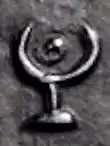
.jpg.webp)

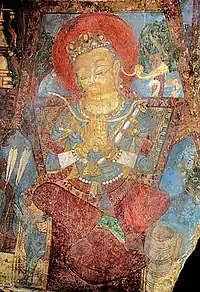
.jpg.webp)
.jpg.webp)